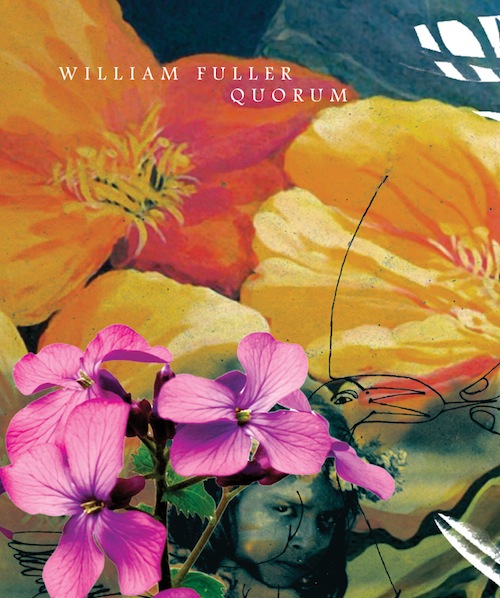William Fuller's Quorum: VOILA ICI AT LAST HOORAY

Put down your cheese danish: William Fuller's latest book, Quorum (Seagull Books 2013), is out! And the reviews are in. At The Quietus: "Where in the World is Quorum? On the Poetry of William Fuller," by Maya Osborne, "Fuller is not interested in shouting a political message to the world; his writing is measured, restrained and quiet enough to coax the world closer to him: Friends, lend him your ears." Plus:
It is rare to find poetry that is both conceptual and deeply meaningful; it reads like a linguistic translation of abstract expressionism, comparable to the paintings of Franz Kline in what appears to be an impulsive gesticulation, but is actually a performed expression: this is a carefully composed work of art.
Part of the reason that Fuller's work feels so hyper expressive is due to his ease with language. He commands description with incredible delicacy and attentiveness:
There's a faint breeze and a fat fig / and a cut stem.The soft and fertile ‘breeze...fat’ is sliced apart and made impotent, ‘a cut stem’. He also circumscribes place and event, which lends a heightened sense of importance to his poems despite their size and regulated structure. This is the case with the final sentences in the last poem of Quorum's part 1, in which minute hints are coupled with a strange and fearful oddness to produce the weirdest of expressive vignettes:
I see traces of hands / and wings. I see a doll's eye pedaling toward the sun.The persistent fourteen-line structure of each poem makes comparison to the sonnet form temptingly easy but somewhat misplaced. The poems avoid any strict metrical rhythm: They remain strikingly intentional in their structure. Yet it soon becomes clear that the line structure is set according to the margins of a Word document – a margin that changes from poem to poem. This begs the question of how much intentionality Fuller invested into the form of his poems prior to their margin adjustments. They sit boxy on the pages; even the fourteenth line snakes its way to the bottom-right corner to complete the cuboid shape. In this respect the poems follow in the aesthetic shoes of shape poetry, particularly the concrete poems of Carl Andre in which materiality is often emphasised over syntax. The fact that Fuller has not chosen to have his poems laid out in a 'justified' format makes this adjustment all the more apparent. Their jagged right edge sharply contrasts with the cleanly aligned strip to the left.
Despite the prescience of margin adjustments, Microsoft Word is perhaps not so much Fuller's artistic director as it is his helpful editor. Line breaks in Quorum feel far from arbitrary; a point in question is the thud of ‘Thoughts shoot’ in ‘The Lecture of Sheep’:
Thoughts shoot / out like flames, soft, white, and thin.Here the line break emphasises the excessive aggression of hurtling thoughts that sit curiously at odds with their delicate and seemingly sickly flame form on the following line. This strange push and pull sentiment haunts the collection – perhaps a preoccupation of Fuller's. His own position as the chief fiduciary officer of Chicago's Northern Trust Company at first glance appears to be at odds with his role as a poet – a job title that famously favours the poorer beatniks and romantic consumptives. Yet although his well-paid employment inevitably seeps into his poetry – a little quip of ‘Don't sell’ in ‘Quorum’ – it would be reductive to see the collection as an echo of Fuller's day job. In fact much of the collection is concerned with re-describing daily life in such a way that it takes on an extraordinary and phantasmagorical quality. . . .
Read it all, get the book, and listen to Fuller's recent reading in New York City (his first there in a decade), in which he reads from Quorum.


